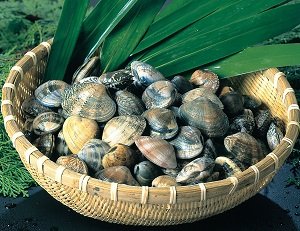Ono Asari
| Registration Number | 89 |
|---|---|
| Name of the GI | Ono Asari |
| Class | Fish and Shellfish |
| Date of Protection | 2019/12/10 |
| Producing Area |
Hiroshima Prefecture
Hatsukaichi City |
| Applicant - Name and Address | Onocho Fisheries Cooperative Ono Fisheries Cooperative Hamakebo Fisheries Cooperative |
Producing Area
Ono Asari is a short-neck clam that generally grows as large as 35 mm or more in shell length.
The meat is fleshy and plump with strong umami, and its broth has a rich flavor. Because Ono Asari contains little sand, has stable quality, and can be used to improve taste and appearance of any dish, it is highly appreciated by customer and consumers. Ono Asari is thus traded at high prices.
Ono Asari is harvested in short-neck clam fisheries in Onoseto off Hatsukaichi City, Hiroshima Prefecture.
Fishermen manage fisheries in their respective assigned blocks, and harvest the clams only in their own blocks by hand digging using a rake at low tide. During harvesting, smaller clams that do not have the characteristics of Ono Asari are returned to their respective fisheries.
By checking their appearance and sound when sieved, only clams that are alive are selected for shipment.
The fishing ground of Ono Asari, Onoseto Strait, is a channel with a total length of 9km and width of 600 m at its narrowest part.
The waters are calm with tidal currents characteristic of a strait, and receive inflows of river water and subsoil water from bountiful forests. This contributes to the stable generation of phytoplankton as feed, which sustains the favorable growth of bivalves in the waters.
The area of tidal flats scattered across the Strait is less than 5 ha on average, and this has led to the adoption of fishery management based on assigning a block to each fisherman and the method of harvesting only by hand digging. Fishery management by zoning has been practiced for a century, and local records remain that show an area of assigned blocks in 1926, and so on.
Today, around 200 fishermen harvest Ono Asari, with annual production stable at about 50 tons.
In recent years, fishermen from across the country visit the area to observe it as a model case for sustainable clam use, and the area also provides opportunities for work experience and teaching materials for integrated learning to local schools.


